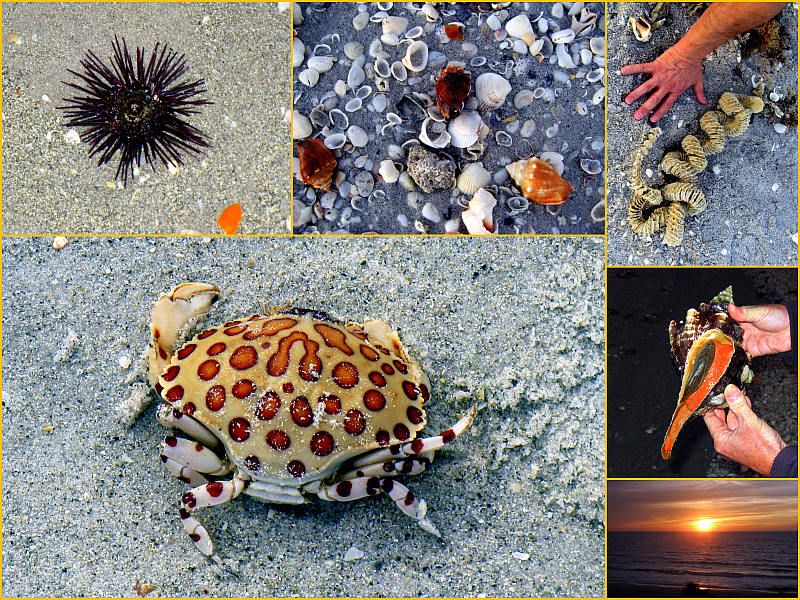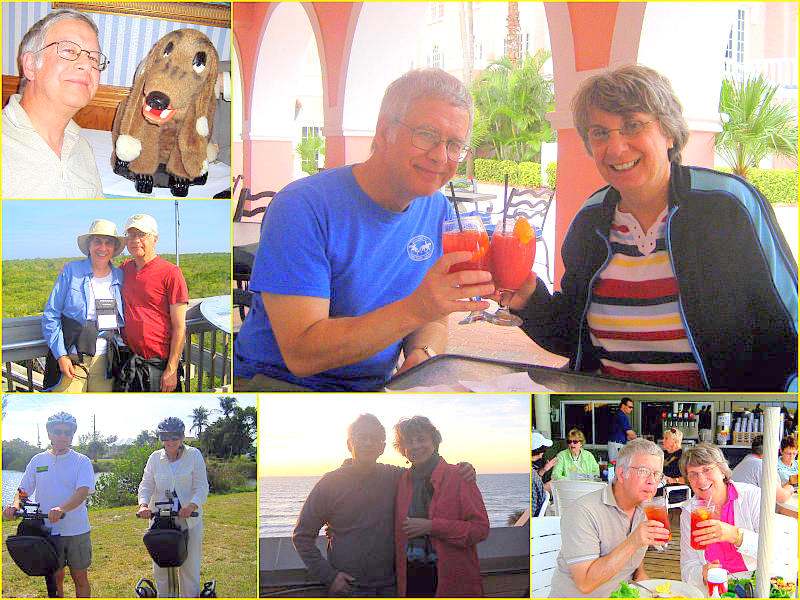
Not Your Ordinary NY Garden
| St. Petersburg and Sanibel Island Florida - February 2012 |
|---|
| | | Return to Home Page | | |
|---|
Having had so much fun on previous Florida winter vacations we opted for a two-week stay this year. We combined time on our own with two consecutive Road Scholar programs, the first in St. Petersburg, >Fins and Feathers: Exploring the Florida Environment From Sea to Sky, the second, Beautiful Sanibel Island and the Southwest Florida Gulf on the barrier island of Sanibel.
The first week, Fins and Feathers program, we stayed at the Eckard College conference center on the campus in St. Petersburg. The second we drove from St. Petersburg to Sanibel Island and the West Wind Inn. Our room looked out onto the ocean, a minute's walk away, with the beach stretching on for miles in both directions. We took morning and evening beach walks each day watching the birds, looking for shells or watching the sunsets. The West Wind was destroyed by hurrican Ian and is in process of being rebuilt. 70% of Sanibel is set aside for conservation uses. Evenings on Sanibel are dark, very dark. No street lights, no traffic lights, no neon all to avoid confusing sea turtles that nest on the beaches.

Not Your Ordinary NY Garden
In the photo above, upper left, citrus hangs heavy from a tree in the garden of the Sanibel Historical Museum. Upper right, a Banyan tree on the grounds of the Edison / Ford Winter Estates in Fort Myers. This single tree covers an acre of ground looking for the entire world like a forest. Lower right, not a rare plant but I found this Foxglove in the Estate's garden particularly lovely. Bottom center, Ever seen a flowering palm tree? This one's on the grounds of Eckard College in St. Petersburg. Bottom left, On the grounds of the Sanibel Holiday Inn bananas ripen on the tree.
| | | Return to Home Page | | |
|---|

Birds I've Never Seen at My Backyard Feeder
In the photo above, upper left, an Osprey searches for its' next meal. They build large stick nests on telephone poles, construction cranes, light stanchion, anything topped with a horizontal surface and near water. Once in place Florida law prohibits nest removal until after fledging season. Upper right, a Great Egret. Lower right, a Little Blue Heron seen in the J.N. Ding Darling National Wildlife Refuge on Sanibel Island. Bottom center, an Anhinga dries its' water soaked feathers in the sun. Unlike other water birds the Inhinga's feathers are not waterproof allowing it to 'fly' underwater searching for food. Lower left, is a Black-crowned Night Heron. The bright red eye is a giveaway.

Critters We Saw
In the photo above upper left, At the Parker Manatee Aquarium we saw Snooty the Manatee, deceased in 2017, munch on a bit of the 175 pounds of Romaine Lettuce he's fed each day. Born in 1948, the oldest known living Manatee, he's spent his entire life in captivity. We spent a fun afternoon at the Clearwater Marine Museum. Upper right, a dolphin. Lower right, a Green Sea Turtle. Bottom center, a Cuban Brown Anole keeps watch for the next insect to come along. I looked for the GEICO Gecko? but sadly the Browns, an invasive species, have crowded out the greens. Lower left, a field of Ant Lion homes dots the sandy ground. Center left, a StingRay swims at Stingray Beach. The skin is as smooth as the finest suede.
| | | Return to Home Page | | |
|---|

On The Beach
Sanibel Island is known for its' beaches in general and shelling on the beaches in particular. While shelling we were afflicted by the Sanibel Stoop. Surrounded by beautiful sun, sea and sky we joined the multitude shuffling up and down the beaches bent over at the waist looking for just the right shell. After a high tide beaches were covered in shells inches deep crunching underfoot as we walked along.
When managing to get upright we enjoyed watching the Pelicans dive bomb for fish, a crowd of Ibis methodically poking into the sand at waters edge for choice morsels while gulls and terns keep an eye out for something, preferably food, to steal.
In the photo above, upper left, remains of a Purple Sea Urchin that was washed up on the beach. Top center, three live Florida Fighting Conchs left on the beach at high tide. Top right, a Lightning Welks' egg case. Right center, a living Horse conch shown to us just before releasing it back to the ocean. A major shelling Though Shall Not is taking living critters off the beach. Lower right, the sun sets into the Gulf of Mexico off Sanibel Island. Lower left, a Calico Crab
| | | Return to Home Page | | |
|---|

Water Birds
In the photo above, upper left, a Yellow-crowned Night-Heron photographed in the Ding Darling National Wildlife Refuge on Sanibel Island. Upper right, a Snowy Egret, the yellow feet are a dead giveaway, on the beach near the West Wind. Lower right, a convention of American White Pelicans and Roseate Spoonbills share the water with their lesser cousins& bottom center, Royal Terns. Lower left, a Brown Pelican on the beach at the Suncoast Seabird Sanctuary. Left center, White Ibis forage for food on the beach. Ibis were everywhere, oblivious to human presence.
| | | Return to Home Page | | |
|---|

The Two of Us
In the photo above upper left, are Ed and Farfel. The hound was created and operated by ventriloquist Jimmy Nelson. Nelson brought Farfel and dummy Danny O'Day to the West Wind Inn for an evening entertainment. I've a strong childhood memory of Farfel singing "N-E-S-T-L-E-S, NestlÚs tastes the very best, CH-A-A-A-W-CLIT." Upper right, we visited the four-star Don CeSar Beach Resort to enjoy a little piece of the high life sipping drinks we never drink at home. Hey we're on vacation!. Lower right, iced tea for lunch at the Sand Bar Restaurant in Anna Maria. Center bottom, on the roof of the Hurricane restaurant in St. Pete Beach a popular spot to watch the sunset into the Gulf. No, I didn't see the green flash, insufficient rum? Lower left, they say you never forget how to ride a bike & they lied. It took less than a second, mounting a bike a bit too tall for me, to hit the pavement. We decided to try something safer, a Segway. Center left, We're at the top of the observation tower high above the Weedon Island Preserve Cultural and Natural History Center.
| | | Return to Home Page | | |
|---|